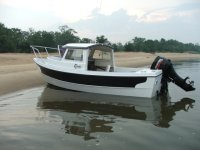Good morning.
I am looking into purchasing a C-Dory in the near future. I will be mostly using the boat in Alaskan water for cruising with my family, fishing and hunting. So my question to those Alaskan forum members is how does a C-Dory handle the water conditions commonly found in PWS, Cook Inlet, etc?
Most likely I will be picking up a used 22' Cruiser but am open to the idea of getting either 25' Cruiser vs. 255 TomCat. Would you recommend going with the larger boat? Is there inherent advantages in getting a larger boat...other than the obvious size differences (i.e.) safety, handling rough water, etc?
I thank you in advance for your time.
Regards,
yhc
I am looking into purchasing a C-Dory in the near future. I will be mostly using the boat in Alaskan water for cruising with my family, fishing and hunting. So my question to those Alaskan forum members is how does a C-Dory handle the water conditions commonly found in PWS, Cook Inlet, etc?
Most likely I will be picking up a used 22' Cruiser but am open to the idea of getting either 25' Cruiser vs. 255 TomCat. Would you recommend going with the larger boat? Is there inherent advantages in getting a larger boat...other than the obvious size differences (i.e.) safety, handling rough water, etc?
I thank you in advance for your time.
Regards,
yhc

